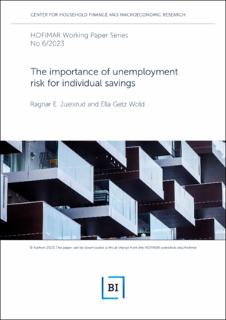| dc.contributor.author | Juelsrud, Ragnar E. | |
| dc.contributor.author | Getz Wold, Ella | |
| dc.date.accessioned | 2024-04-04T15:32:11Z | |
| dc.date.available | 2024-04-04T15:32:11Z | |
| dc.date.issued | 2023 | |
| dc.identifier.issn | 2704-1980 | |
| dc.identifier.uri | https://hdl.handle.net/11250/3124935 | |
| dc.description.abstract | In this paper we use a novel natural experiment and Norwegian tax data to quantify the causal impact of unemployment risk on individual savings. We show theoretically that higher unemployment risk increases liquid savings and has an ambiguous impact on illiquid savings in partial equilibrium. In line with the model predictions, our empirical results confirm that a one percentage point increase in unemployment rates increases liquid savings by 1.3 percent in the cross-section. Reassuringly, this effect is driven by low-tenured workers, who face the highest increase in risk. Illiquid savings remain unaffected, implying an increase in the overall liquidity of individual saving portfolios. Using two independent approaches to quantify the overall importance of the unemployment risk channel in explaining saving dynamics during recessions, we find that at least 80% of the recession-induced increase in liquid savings can be explained by higher unemployment risk. | en_US |
| dc.language.iso | eng | en_US |
| dc.publisher | BI Norwegian Business School | en_US |
| dc.relation.ispartofseries | HOFIMAR Working Paper Series;6/2023 | |
| dc.subject | Unemployment risk | en_US |
| dc.subject | Precautionary savings | en_US |
| dc.subject | Portfolio allocation | en_US |
| dc.subject | Household finance | en_US |
| dc.subject | Regressions | en_US |
| dc.subject | Uncertainty | en_US |
| dc.title | The importance of unemployment risk for individual savings | en_US |
| dc.type | Working paper | en_US |
| dc.source.pagenumber | 58 | en_US |
